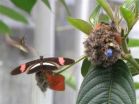(Press-News.org) COLUMBUS, Ohio – The development of a new cell-culture system that mimics how specific nerve cell fibers in the brain become coated with protective myelin opens up new avenues of research about multiple sclerosis. Initial findings suggest that myelin regulates a key protein involved in sending long-distance signals.
Multiple sclerosis (MS) is an autoimmune disease characterized by damage to the myelin sheath surrounding nerve fibers. The cause remains unknown, and it is a chronic illness affecting the central nervous system that has no cure.
MS has long been considered a disease of white matter, a reference to the white-colored bundles of myelin-coated axons that project from the main body of a brain cell. But researchers have discovered that the condition also affects myelinated axons scattered in gray matter that contains main bodies of brain cells, and specifically the hippocampus region, which is important for learning and memory.
Up to half of MS patients suffer cognitive deficits in addition to physical symptoms. Researchers suspect that cognitive problems are caused by abnormal electrical activities of the demyelinated axons extending from hippocampal cells, but until now have not been able to test myelin's role in this part of the brain.
Ohio State University researchers have created a system in which two types of cells interact in a dish as they do in nature: neurons from the hippocampus and other brain cells, called oligodendrocytes, whose role is to wrap myelin around the axons.
Now that the researchers can study how myelination is switched on and off for hippocampal neurons, they also can see how myelin does more than provide insulation – it also has a role in controlling nerve impulses traveling between distant parts of the nervous system. Identifying this mechanism when myelin is present will help improve understanding of what happens when axons in this critical area of the brain lose myelin as a result of MS, researchers say.
So far, the scientists have used the system to show that myelin regulates the placement and activity of a key protein, called a Kv1.2 voltage-gated potassium channel, that is needed to maintain ideal conditions for the effective transmission of electrical signals along these hippocampal axons.
"This channel is important because it is what leads to electrical activity and how neurons communicate with each other downstream," said Chen Gu, assistant professor of neuroscience at Ohio State and lead author of the study. "If that process is disrupted by demyelination, disease symptoms may occur."
The study appears in the current (July 22, 2011) issue of the Journal of Biological Chemistry.
To create the cell culture system, the researchers began with hippocampus neurons from a rodent brain – a cell type that Gu has worked with for years. In culture, these cells can grow and develop dendrites – other branch-like projections off of neurons – and axons as well as generate electrical activity and synaptic connections, the same events that occur in the brain.
The researchers then added oligodendrocytes, along with some of their precursor cells, to the same dish as the neurons. And eventually, after maturing, these oligodendrocytes began to wrap myelin around the axons of the hippocampal neurons.
This system takes about five weeks to create, but the trickiest part, Gu said, was developing the proper solution for this culture so that both kinds of cells would behave as nature intended.
"In the end, the composition of the culture medium is basically half from a solution that supports the neurons and half from a medium in which the oligodendrocytes function well. We know that all the cells were happy because we got myelin," said Gu, also an investigator in Ohio State's Center for Molecular Neurobiology.
With the system established, they then turned to experimentation to test the effects of the myelin's presence on these specific brain cells.
Nerve cells send their signals encoded in electrical impulses over long distances. Concerted actions of various ion channels are required for properly generating these nerve impulses. Potassium channels are involved at the late phase in an impulse, and its role is to return a nerve cell to a resting state after the impulse has passed through it and gear up for the next one. The Kv1.2 ion channel helps ensure that this process works smoothly.
By experimentally manipulating signal conditions with the new co-culture system, Gu and his colleague were able to establish part of the sequence of events required for myelinated hippocampal neurons to effectively get their signals to their targets. Starting with a protein known to be produced by myelin and axons, called TAG-1, a cell adhesion molecule, they traced a series of chemical reactions indicating that myelin on the hippocampal axons was controlling the placement and activity of the Kv1.2 ion channel.
"The analysis allowed us to see the signaling pathways involving myelin's regulation of the Kv1.2 channel's placement along the axon as well as fine-tuning of the channel's activity," Gu said.
When MS demyelinates these axons, the affected nerve cells don't get the message to rest, and subsequently can't prepare adequately to receive and transmit the next signal that comes along.
"This means a nerve impulse will have a hard time traveling through the demyelinated region," Gu said. "This shows that the ion channel is probably involved in the downstream disease progression of MS."
Gu envisions many additional uses for the new co-culture system, including additional studies of how myelin affects the behavior of other channels, proteins and molecules that function within axons, as well as to screen the effects of experimental drugs on these myelinated cells.
This work was supported by a Career Transition Fellowship Award from the National Multiple Sclerosis Society and a grant from the National Institute for Neurological Disorders and Stroke.
###
Gu conducted this study with Yuanzheng Gu, a research associate in the Department of Neuroscience at Ohio State.
Contact: Chen Gu, (614) 292-0349; gu.49@osu.edu
Written by Emily Caldwell, (614) 292-8410; caldwell.151@osu.edu
END
Rockville, Md. — Several reports indicate that prolonged viewing of mobile devices and other stereo 3D devices leads to visual discomfort, fatigue and even headaches. According to a new Journal of Vision study, the root cause may be the demand on our eyes to focus on the screen and simultaneously adjust to the distance of the content.
Scientifically referred to as vergence-accommodation, this conflict and its effect on viewers of stereo 3D displays are detailed in a recent Journal of Vision article, The Zone of Comfort: Predicting Visual Discomfort with Stereo Displays. ...
Stem cell researchers at UCLA have generated the first genome-wide mapping of a DNA modification called 5-hydroxymethylcytosine (5hmC) in embryonic stem cells, and discovered that it is predominantly found in genes that are turned on, or active.
The finding by researchers with the Eli and Edythe Broad Center of Regenerative Medicine and Stem Cell Research at UCLA may prove to be important in controlling diseases like cancer, where the regulation of certain genes plays a role in disease development.
"Any way you can control genes will be hugely important for human ...
Red may mean STOP or I LOVE YOU! A red splash on a toxic butterfly's wing screams DON'T EAT ME! In nature, one toxic butterfly species may mimic the wing pattern of another toxic species in the area. By using the same signal, they send a stronger message: DON'T EAT US!
Now several research teams that include Smithsonian scientists in Panama, have discovered that Heliconius butterflies mimic each other's red wing patterns through changes in the same gene.
Not only does this gene lead to the same red wing patterns in neighboring species, it also leads to a large variety ...
MINNEAPOLIS / ST. PAUL (July 21, 2011) – A normal but concerning consequence of pregnancy is the fact that pregnant women are more susceptible to infection. University of Minnesota Medical School researchers have identified the underlying mechanisms for this physiologic immune suppression that may lead to new therapies to help ward off infections during pregnancy.
In pregnancy, immune system suppressing cells (called regulatory T cells) increase in number to protect the baby from attack by the mother's immune system. Because these cells are busy protecting the developing ...
A genetic study focusing on the Central American river turtle (Dermatemys mawii) recently turned up surprising results for a team of Smithsonian scientists involved in the conservation of this critically endangered species. Small tissue samples collected from 238 wild turtles at 15 different locations across their range in Southern Mexico, Belize and Guatemala revealed a "surprising lack" of genetic structure, the scientists write in a recent paper in the journal Conservation Genetics.
The turtles, which are entirely aquatic, represent populations from three different ...
Recent research conducted at Harvard Medical School and the Harvard School of Public Health may have strong implications for informing the controversial debate currently surrounding national health care reform.
In a study published in the July edition of the American Journal of Preventive Medicine, the Harvard research team, led by first author Aakanksha Pande, a doctoral student in the Department of Population Medicine at HMS and Harvard Pilgrim Health Care Institute, found that Massachusetts health reform has effectively increased access to health care and reduced disparities. ...
ANN ARBOR, Mich. — Children with public insurance are 22 percent less likely to receive comprehensive primary care than those with private insurance, according to new research from the University of Michigan Medical School.
Public insurance programs cover one-third of U.S. children, many of whom belong to the most vulnerable groups, including minorities, the underprivileged and those in poor health. This includes children covered by Medicaid and the Children's Health Insurance Program (CHIP).
The study, available online ahead of print in Academic Pediatrics, determined ...
The eye of a tropical cyclone is an indication of a strong storm, and Typhoon Ma-on's eye was apparent in visible and infrared imagery captured by NASA's Aqua satellite. Ma-on just achieved Category Four status on the Saffir-Simpson scale that measures hurricane intensity.
The Moderate Resolution Imaging Spectroradiometer (MODIS) instrument that flies aboard NASA's Aqua satellite took an image of Typhoon Ma-on that clearly shows the storm's eye, although it has some high clouds in it. The image was taken at 04:15 UTC (12:15 a.m. EDT) on July 15 as Typhoon Ma-on continues ...
Fires raging in central Africa are generating a high amount of pollution that is showing up in data from NASA's Aura Satellite, with the ominous shape of a dark red butterfly in the skies over southern part of the Democratic Republic of the Congo and northern Angola.
An image of the pollution from agricultural fires in central Africa was created from data of nitrogen dioxide (NO2) levels over the period from July 7 to 12, 2011. It was created from Ozone Measuring Instrument (OMI) data using the NASA Giovanni system by Dr. James Acker at NASA's Goddard Space Flight Center ...
BOSTON—Nursing home residents taking certain antidepressant medications are at an increased risk of falling in the days following the start of a new prescription or a dose increase of their current drug, according to a new study by the Institute for Aging Research of Hebrew SeniorLife, an affiliate of Harvard Medical School.
Published online in the Journal of Gerontology: Medical Sciences, the study found that nursing home residents have a fivefold increased risk of falling within two days of a new prescription for or an increased dose of a non-SSRI (selective serotonin ...



